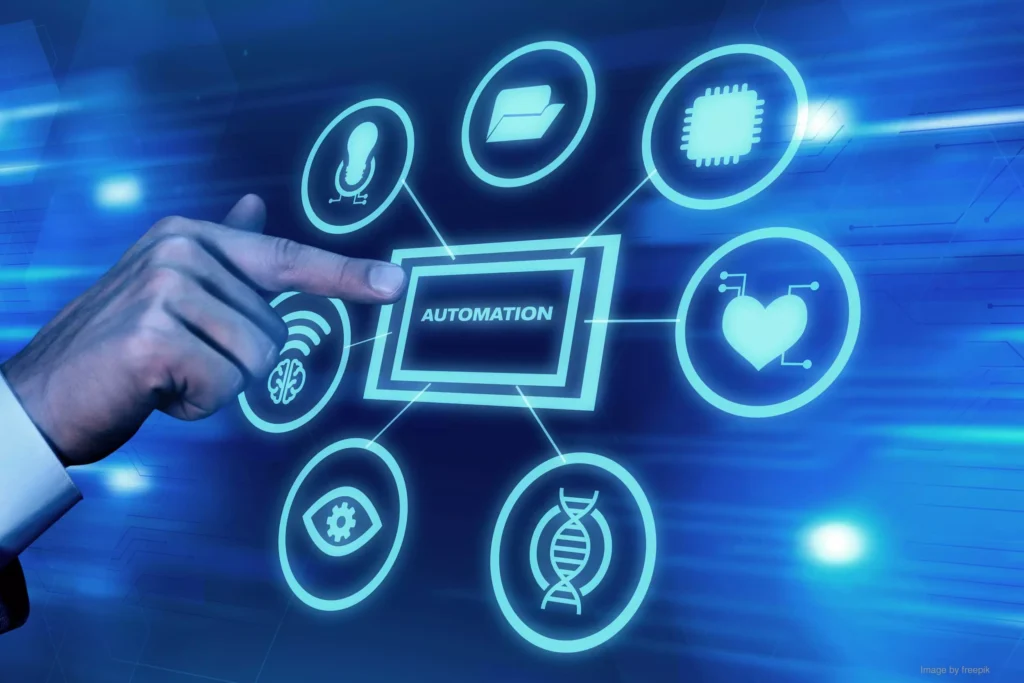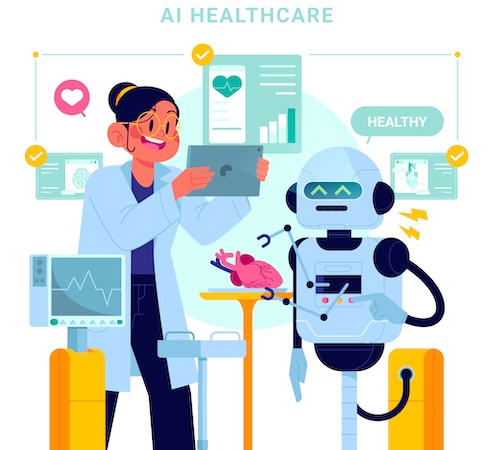The healthcare industry, a cornerstone of society, is constantly striving for improved patient outcomes, greater efficiency, and reduced costs. In this pursuit, automation has emerged as a transformative force, revolutionizing everything from administrative tasks to complex medical procedures. Far from replacing human empathy and clinical expertise, automation acts as a powerful enabler, freeing up healthcare professionals to focus on what truly matters: providing high-quality, personalized care.
The sheer volume of data, the complexity of regulations, and the ever-increasing demand for services make healthcare a prime candidate for automation. From artificial intelligence (AI) and robotic process automation (RPA) to intelligent data analytics and telehealth platforms, a myriad of technologies are reshaping how healthcare operates. Let’s delve into the myriad of areas where automation is making a profound impact, exploring the tangible benefits and the exciting possibilities for the future.

Streamlining Administrative Burdens: The Foundation of Efficiency
One of the most immediate and impactful areas for automation in healthcare lies in alleviating the heavy administrative load that often bogs down staff. Think about the countless hours spent on paperwork, data entry, scheduling, and billing – tasks that are repetitive, time-consuming, and prone to human error.
- Patient Scheduling and Appointment Management: Manually scheduling appointments is a logistical nightmare, fraught with the potential for conflicts and missed opportunities. Automated scheduling systems, powered by AI and RPA, can handle the entire process, from initial booking to sending out reminders via SMS or email. They can even intelligently optimize schedules based on clinician availability, patient preferences, and the nature of the appointment, significantly reducing no-show rates and improving patient flow.
- Patient Intake and Registration: The patient intake process, often a source of frustration for both patients and staff, can be largely automated. Online portals allow patients to pre-register, fill out forms, and provide necessary information before their visit. AI-powered chatbots can guide them through the process, answer frequently asked questions, and even help with insurance verification, ensuring a smoother and faster arrival experience.
- Electronic Health Records (EHR) Management and Documentation: EHRs are the backbone of modern healthcare, but manual data entry into these systems can be laborious and error-prone. Automation can significantly streamline this.
- Automated Data Capture: Tools can extract information from various sources (scanned documents, faxes, patient portals) and automatically populate EHR fields, reducing manual keying.
- Clinical Documentation Assistance: Generative AI can assist clinicians by automatically transcribing patient-provider conversations, generating detailed notes, and even suggesting relevant codes, freeing up valuable time for direct patient interaction. This not only improves efficiency but also enhances the accuracy and completeness of patient records.
- Interoperability: Automation can facilitate seamless data exchange between different EHR systems and other healthcare platforms, addressing the long-standing challenge of interoperability and ensuring a holistic view of patient information.
- Medical Billing and Claims Processing: This is a notoriously complex and error-prone area. Automation, particularly RPA, can revolutionize revenue cycle management:
- Automated Coding: AI can analyze clinical documentation and suggest appropriate billing codes, minimizing manual effort and enhancing accuracy, which directly impacts reimbursement.
- Claims Submission and Tracking: RPA bots can automatically prepare and submit claims to insurance companies, track their status, and identify and resolve discrepancies, accelerating the billing cycle and reducing denials.
- Payment Posting: Automated systems can reconcile payments received against billed services, reducing manual data entry and improving financial accuracy.
- Referral Management: Managing patient referrals between different specialists and departments can be a convoluted process. Automated systems can track referrals, send reminders, and ensure all necessary documentation is shared efficiently, leading to better coordinated care.
- Supply Chain and Inventory Management: Healthcare organizations require a vast array of medical supplies and equipment. Automating the supply chain can lead to significant cost savings and improved efficiency:
- Real-time Inventory Monitoring: IoT devices and automated systems can track stock levels in real time, triggering alerts when supplies run low and even initiating automatic reorders. This prevents stockouts, reduces waste, and ensures critical supplies are always available.
- Predictive Analytics for Demand Forecasting: AI can analyze historical data and market trends to predict future demand for specific supplies, optimizing procurement cycles and minimizing overstocking or understocking.
- Automated Procurement Workflows: From purchase requests to vendor compliance, automation streamlines the entire procurement process, reducing delays and improving vendor relationships.
Enhancing Patient Experience and Engagement: A New Era of Care
Beyond internal efficiencies, automation plays a crucial role in improving the patient experience and fostering greater engagement in their own healthcare journey.

- Automated Patient Communication: Keeping patients informed is paramount. Automation enables:
- Appointment Reminders: Automated calls, SMS, or email reminders significantly reduce no-shows.
- Post-Visit Instructions and Follow-ups: Automated messages can reinforce discharge instructions, provide medication reminders, and prompt patients for follow-up appointments, improving adherence to care plans.
- Patient Surveys and Feedback Collection: Automated surveys can be sent out after visits to gather feedback, allowing healthcare providers to identify areas for improvement and enhance patient satisfaction.
- Virtual Assistants and Chatbots: AI-powered virtual assistants and chatbots can provide 24/7 support to patients:
- Answering FAQs: They can address common questions about services, hours, or symptoms, freeing up human staff.
- Symptom Triaging: Some advanced chatbots can even perform preliminary symptom assessments and guide patients to the appropriate care level or specialist.
- Medication Reminders: Chatbots can be programmed to send personalized medication reminders.
- Personalized Health Information Delivery: Automation can tailor educational materials and health information to individual patients based on their conditions, treatment plans, and preferences, empowering them to take a more active role in managing their health.
- Telehealth and Remote Patient Monitoring Integration: While telehealth itself is a service, automation enhances its effectiveness:
- Automated Scheduling for Telehealth Visits: Similar to in-person appointments, virtual visits can be seamlessly scheduled and managed.
- Automated Data Collection from Wearables: Data from smartwatches, glucose monitors, and other wearable devices can be automatically collected and integrated into EHRs, allowing providers to monitor patients with chronic conditions in real-time and intervene proactively.
- Automated Alerts for Abnormal Readings: If a patient’s vital signs or other health metrics fall outside a predefined range, automated alerts can be sent to healthcare providers, enabling timely intervention.
Revolutionizing Clinical Operations and Diagnostics: The Core of Medical Care
The impact of automation extends directly into clinical processes, leading to more accurate diagnoses, efficient treatments, and improved patient outcomes.
- Diagnostic Imaging and Analysis: AI is transforming radiology and pathology:
- Automated Image Analysis: AI algorithms can analyze X-rays, MRIs, CT scans, and other medical images with remarkable speed and accuracy, identifying subtle abnormalities that might be missed by the human eye. This assists in early detection of diseases like cancer, improving prognosis.
- Streamlined Workflow for Radiologists: AI can prioritize scans requiring immediate attention, reducing the workload on radiologists and speeding up diagnosis times.
- Drug Discovery and Development: The pharmaceutical industry is heavily leveraging AI and automation:
- Accelerated Drug Discovery: AI can analyze vast molecular datasets to identify potential drug candidates, predict their efficacy and toxicity, and optimize their design, significantly shortening the drug discovery process.
- Automated Lab Procedures: Robotics are being used in labs to automate repetitive tasks like pipetting and sample analysis, increasing throughput and accuracy.
- Precision Medicine: Automation and AI are key to realizing the promise of personalized medicine:
- Genomic Data Analysis: AI can analyze vast amounts of genomic data to identify genetic predispositions to diseases and predict individual responses to different treatments, allowing for highly tailored therapies.
- Personalized Treatment Plans: Based on a patient’s unique genetic makeup, lifestyle, and medical history, AI can help develop highly individualized treatment plans.
- Robotic-Assisted Surgery: Surgical robots, controlled by highly skilled surgeons, enhance precision, minimize invasiveness, and reduce recovery times for patients. These systems offer magnified 3D views and a wider range of motion than human hands, leading to more accurate and less traumatic procedures.
- Predictive Analytics for Patient Outcomes: By analyzing historical patient data, AI can predict the likelihood of certain outcomes, such as readmissions or complications. This allows healthcare providers to intervene earlier, adjust treatment plans, and implement preventive measures, leading to better patient safety and reduced healthcare costs.
- Infection Control and Hygiene: Robots are increasingly being used for tasks like disinfecting hospital rooms using UV light, reducing the risk of healthcare-associated infections and ensuring a safer environment for patients and staff.
- Medication Dispensing and Management: Automated dispensing systems in pharmacies and hospitals reduce medication errors, ensure accurate dosages, and manage inventory more efficiently.
Addressing Challenges and The Future of Healthcare Automation
While the benefits of automation in healthcare are undeniable, implementing these technologies comes with its own set of challenges.
- High Implementation Costs: The initial investment in automation technologies can be substantial, posing a barrier for smaller healthcare providers.
- Data Security and Privacy Concerns: Healthcare data is highly sensitive, and robust cybersecurity measures are crucial to protect patient privacy and comply with regulations like HIPAA.
- Integration with Legacy Systems: Many healthcare institutions still rely on outdated IT infrastructure, making seamless integration of new automation solutions a complex task.
- Resistance to Change: Healthcare professionals, accustomed to traditional workflows, may be hesitant to adopt new technologies. Comprehensive training and clear communication about the benefits are essential to overcome this.
- Algorithmic Bias: If the data used to train AI algorithms contains biases, the automated systems may perpetuate or even amplify those biases, leading to inequitable outcomes. Careful data curation and ongoing monitoring are vital.
- Ethical Considerations: As AI takes on more decision-making roles, ethical questions surrounding accountability, transparency, and the human-AI interface become paramount.
Despite these challenges, the future of automation in healthcare is incredibly promising. We can expect to see:
- More Sophisticated AI and Generative AI: Advancements in AI will lead to even more intelligent and autonomous systems, capable of handling increasingly complex tasks, from nuanced diagnostic interpretations to generating personalized patient education materials.
- Increased Interoperability: Greater standardization and technological advancements will lead to more seamless data exchange between disparate healthcare systems, creating a truly connected healthcare ecosystem.
- Wider Adoption of Robotics: Robots will become more common in various healthcare settings, assisting with everything from patient transport to performing delicate surgical procedures.
- Hyper-Personalized Healthcare: The combination of AI, automation, and wearable technology will enable an unprecedented level of personalized care, tailored to each individual’s unique needs and real-time health data.
- Focus on Preventive Care: Automation will play a larger role in identifying individuals at risk for certain conditions and facilitating proactive interventions, shifting the focus from reactive treatment to preventive care.
- Upskilling the Workforce: Instead of replacing human jobs, automation will create new roles and necessitate upskilling of the healthcare workforce, as professionals learn to collaborate effectively with AI and automated systems.
The healthcare industry stands at the precipice of a technological renaissance. By strategically embracing automation, healthcare organizations can unlock unprecedented levels of efficiency, improve the quality and accessibility of care, and ultimately, create a healthier future for all. The journey is ongoing, but the path towards an automated, intelligent, and compassionate healthcare system is clearly defined.



1 thought on “Unlocking Efficiency and Excellence: Things You Can Automate in the Healthcare Industry”